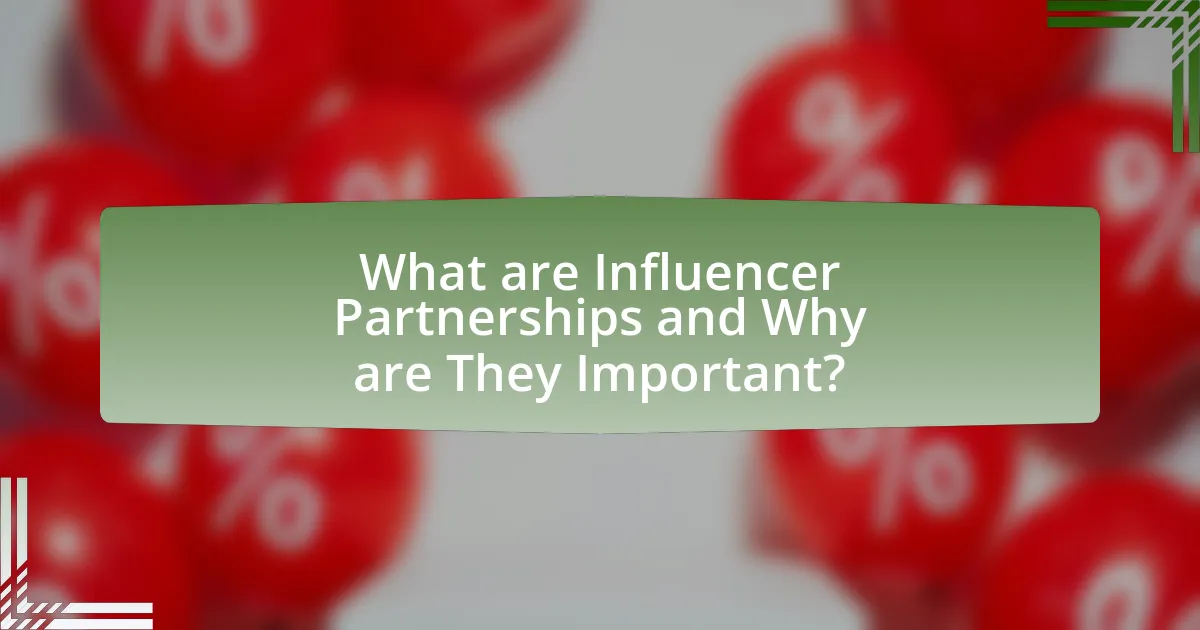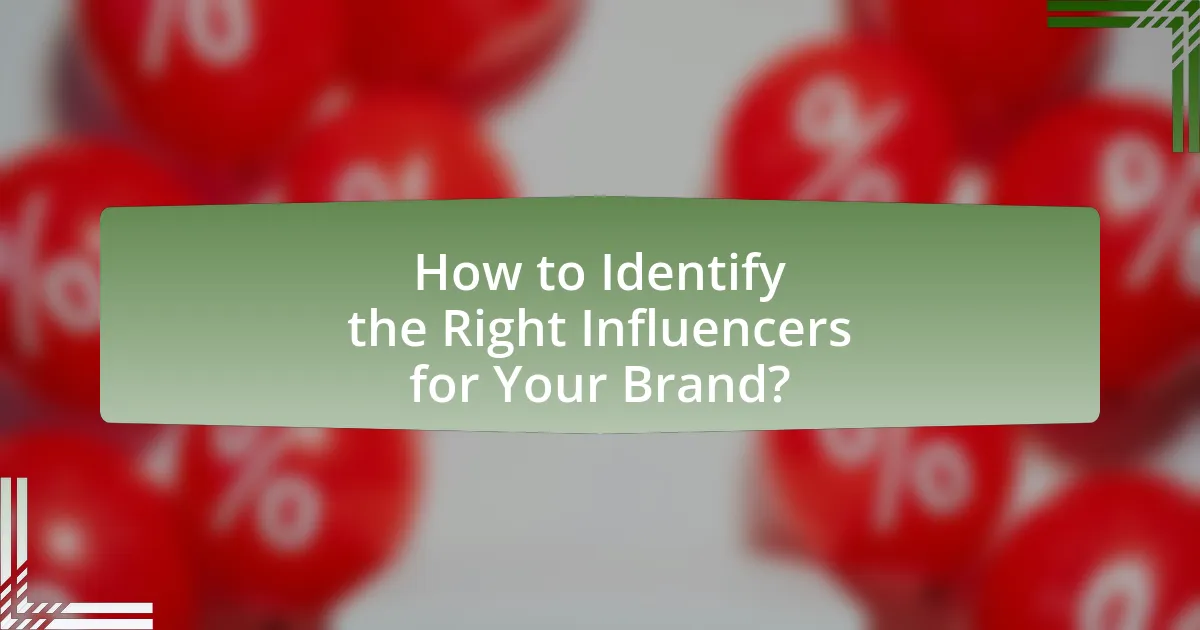Influencer partnerships are collaborative relationships between brands and individuals with substantial social media followings, crucial for effective marketing strategies. This article explores the significance of these partnerships, detailing how they function, the types of influencers available, and their impact on consumer behavior. Key benefits such as enhanced brand visibility, credibility, and engagement are highlighted, along with strategies for selecting the right influencers and maximizing campaign effectiveness. Additionally, the article addresses common challenges brands face in influencer marketing and offers practical tips for successful collaborations, ensuring brands can leverage these partnerships for maximum reach and impact.

What are Influencer Partnerships and Why are They Important?
Influencer partnerships are collaborative relationships between brands and individuals who have significant social media followings, allowing brands to leverage the influencer’s audience for marketing purposes. These partnerships are important because they enable brands to reach targeted demographics more effectively; for instance, a study by Nielsen found that 92% of consumers trust recommendations from individuals over brands, highlighting the credibility influencers hold. Additionally, influencer partnerships can enhance brand visibility and engagement, as influencers often create authentic content that resonates with their followers, leading to higher conversion rates.
How do Influencer Partnerships work in marketing?
Influencer partnerships in marketing involve brands collaborating with individuals who have a significant following on social media or other platforms to promote products or services. These partnerships typically function through a structured agreement where influencers create content that showcases the brand, often leveraging their authenticity and reach to engage their audience effectively.
For instance, a study by the Digital Marketing Institute found that 49% of consumers depend on influencer recommendations when making purchasing decisions, highlighting the effectiveness of these partnerships in driving consumer behavior. Brands often select influencers whose audience aligns with their target demographic, ensuring that the promotional content resonates with potential customers.
What types of influencers can brands partner with?
Brands can partner with various types of influencers, including mega influencers, macro influencers, micro influencers, and nano influencers. Mega influencers typically have over a million followers and can provide extensive reach, while macro influencers, with followers ranging from 100,000 to a million, often have a more engaged audience. Micro influencers, who have between 1,000 and 100,000 followers, tend to have high engagement rates and niche audiences, making them effective for targeted campaigns. Nano influencers, with fewer than 1,000 followers, can offer authentic connections within small communities. This categorization is supported by research indicating that micro and nano influencers often yield higher engagement rates compared to their larger counterparts, making them valuable for brands seeking to maximize reach and impact.
How do influencers impact consumer behavior?
Influencers significantly impact consumer behavior by shaping perceptions and driving purchasing decisions through their credibility and relatability. Research indicates that 49% of consumers depend on influencer recommendations when making purchase decisions, highlighting the effectiveness of influencers in building trust and authenticity. Additionally, a study by the Digital Marketing Institute found that 70% of teenagers trust influencers more than traditional celebrities, demonstrating their ability to connect with audiences on a personal level. This connection often leads to increased brand awareness and higher conversion rates, as consumers are more likely to engage with brands endorsed by influencers they admire.
What are the key benefits of leveraging Influencer Partnerships?
Leveraging influencer partnerships offers key benefits such as enhanced brand visibility, increased credibility, and improved audience engagement. Influencers possess established trust with their followers, which allows brands to tap into a pre-existing audience that is more likely to convert. For instance, a study by Nielsen found that 92% of consumers trust recommendations from individuals over brands, highlighting the effectiveness of influencer endorsements. Additionally, influencer partnerships can lead to higher return on investment (ROI); according to a report by Influencer Marketing Hub, businesses earn an average of $5.78 for every dollar spent on influencer marketing. These benefits collectively contribute to a more effective marketing strategy, driving both brand awareness and sales.
How do Influencer Partnerships enhance brand visibility?
Influencer partnerships enhance brand visibility by leveraging the influencer’s established audience and credibility to reach a wider demographic. When brands collaborate with influencers, they gain access to the influencer’s followers, who often trust the influencer’s recommendations, leading to increased brand awareness and engagement. According to a study by Nielsen, 92% of consumers trust recommendations from individuals over brands, highlighting the effectiveness of influencer marketing in enhancing visibility. Additionally, influencer partnerships can generate authentic content that resonates with audiences, further amplifying brand presence across social media platforms.
What role do Influencer Partnerships play in building trust?
Influencer partnerships play a crucial role in building trust by leveraging the established credibility and authenticity of influencers within their communities. When influencers endorse a brand or product, their followers often perceive these endorsements as genuine recommendations, which can significantly enhance the brand’s reputation. Research indicates that 70% of teenagers trust influencers more than traditional celebrities, highlighting the effectiveness of influencer partnerships in fostering trust among target audiences. This trust is further reinforced when influencers share personal experiences with the products, making their endorsements more relatable and credible.

How to Identify the Right Influencers for Your Brand?
To identify the right influencers for your brand, analyze their audience demographics, engagement rates, and content relevance. Brands should ensure that the influencer’s followers align with their target market, as this increases the likelihood of effective outreach. For instance, a study by Influencer Marketing Hub found that influencers with a highly engaged audience can achieve up to 11 times higher ROI compared to traditional marketing methods. Additionally, reviewing the influencer’s previous collaborations and content style helps determine if their values and messaging resonate with your brand’s identity.
What criteria should you consider when selecting influencers?
When selecting influencers, consider their audience alignment, engagement rate, authenticity, and content quality. Audience alignment ensures that the influencer’s followers match your target demographic, which is crucial for effective messaging. Engagement rate, calculated by the number of interactions relative to follower count, indicates how actively the audience interacts with the influencer’s content, with higher rates suggesting a more engaged audience. Authenticity is vital; influencers who genuinely connect with their audience foster trust, leading to better campaign outcomes. Lastly, content quality reflects the influencer’s ability to create visually appealing and relevant posts, which can enhance brand perception. Research shows that campaigns with authentic influencers can yield up to 11 times higher ROI compared to traditional advertising methods.
How does audience alignment affect influencer selection?
Audience alignment significantly affects influencer selection by ensuring that the influencer’s followers match the target demographic of the brand. When brands choose influencers whose audiences share similar interests, values, and demographics, they increase the likelihood of engagement and conversion. For instance, a study by Influencer Marketing Hub found that campaigns with well-aligned audiences can achieve up to 11 times higher ROI compared to those without alignment. This alignment fosters authenticity and trust, which are critical for effective influencer marketing.
What metrics can help evaluate an influencer’s effectiveness?
Key metrics to evaluate an influencer’s effectiveness include engagement rate, reach, impressions, conversion rate, and audience demographics. Engagement rate, calculated by dividing total interactions (likes, comments, shares) by total followers, indicates how well the influencer connects with their audience. Reach measures the total number of unique users who see the content, while impressions count the total views, providing insight into visibility. Conversion rate tracks the percentage of users who take a desired action, such as making a purchase, after interacting with the influencer’s content. Audience demographics reveal the characteristics of the influencer’s followers, ensuring alignment with the brand’s target market. These metrics collectively provide a comprehensive view of an influencer’s impact and effectiveness in driving brand objectives.
How can you assess an influencer’s authenticity?
To assess an influencer’s authenticity, analyze their engagement metrics, audience demographics, and content consistency. Authentic influencers typically have high engagement rates, indicating genuine interaction with their followers, rather than inflated follower counts from bots or inactive accounts. For example, a study by HypeAuditor found that influencers with a 3% engagement rate or higher are often considered authentic. Additionally, reviewing the demographics of their audience can reveal whether their followers align with the target market, further validating their influence. Lastly, consistency in messaging and values across their content helps confirm their authenticity, as genuine influencers maintain a coherent brand identity that resonates with their audience.
What signs indicate a genuine influencer?
A genuine influencer demonstrates authenticity, engagement, and expertise in their niche. Authenticity is shown through consistent messaging and transparency about partnerships, which builds trust with their audience. High engagement rates, such as likes, comments, and shares, indicate that their followers value their content and are actively participating in discussions. Additionally, a genuine influencer possesses expertise, often sharing valuable insights or knowledge that resonates with their audience, further establishing credibility. These signs collectively affirm the influencer’s genuine status in the digital landscape.
How can engagement rates inform your decision?
Engagement rates can inform your decision by indicating the effectiveness of content in resonating with the audience. High engagement rates suggest that the audience finds the content relevant and compelling, which can guide the selection of influencers whose audiences align with your target demographic. For instance, a study by HubSpot found that posts with higher engagement rates lead to increased brand awareness and customer loyalty, demonstrating that engagement is a key metric for evaluating influencer partnerships. Thus, analyzing engagement rates allows brands to make data-driven decisions about which influencers to collaborate with for maximum reach and impact.

What Strategies Can Maximize the Impact of Influencer Partnerships?
To maximize the impact of influencer partnerships, brands should focus on aligning their values with those of the influencer, ensuring authentic engagement with the audience. Research indicates that 92% of consumers trust recommendations from individuals over brands, highlighting the importance of genuine connections. Additionally, utilizing data analytics to track engagement metrics can refine strategies, as brands that analyze performance data see a 20-30% increase in campaign effectiveness. Collaborating on creative content that resonates with the influencer’s audience further enhances reach and impact, as tailored messaging leads to higher conversion rates.
How can you create effective collaboration agreements?
To create effective collaboration agreements, clearly define the roles, responsibilities, and expectations of all parties involved. This ensures that each participant understands their contributions and the overall objectives of the partnership. Establishing measurable goals and timelines within the agreement facilitates accountability and progress tracking. Additionally, including terms for communication, conflict resolution, and intellectual property rights protects the interests of all collaborators. Research indicates that well-structured agreements can enhance partnership success rates by up to 30%, as they minimize misunderstandings and align objectives.
What elements should be included in an influencer contract?
An influencer contract should include key elements such as the scope of work, compensation details, content ownership, disclosure requirements, and termination clauses. The scope of work defines the specific tasks the influencer will perform, such as creating posts or attending events. Compensation details outline payment terms, including amounts and payment schedules. Content ownership specifies who retains rights to the created content, which is crucial for both parties. Disclosure requirements ensure compliance with advertising regulations, mandating that influencers disclose paid partnerships. Termination clauses provide conditions under which either party can end the agreement, protecting both sides. These elements are essential for clarity and legal protection in influencer partnerships.
How can you ensure mutual benefits in partnerships?
To ensure mutual benefits in partnerships, establish clear goals and expectations from the outset. This involves both parties collaboratively defining what success looks like, which can include metrics such as increased brand awareness, sales targets, or audience engagement levels. Research indicates that partnerships with aligned objectives lead to a 30% higher success rate in achieving desired outcomes. Regular communication and feedback loops further enhance the partnership, allowing for adjustments based on performance data and evolving needs. By fostering transparency and accountability, both partners can maximize their contributions and benefits, ultimately leading to a more fruitful collaboration.
What types of content work best for influencer collaborations?
Visual content, such as images and videos, works best for influencer collaborations. This type of content captures attention quickly and is highly shareable across social media platforms. According to a study by HubSpot, visual content is 40 times more likely to be shared on social media than other types of content. Additionally, authentic storytelling through personal experiences or testimonials enhances engagement, as consumers are more likely to trust influencers who share relatable narratives.
How can storytelling enhance influencer marketing campaigns?
Storytelling can enhance influencer marketing campaigns by creating emotional connections between the audience and the brand. When influencers share authentic narratives that resonate with their followers, it fosters trust and engagement, leading to higher conversion rates. Research indicates that campaigns utilizing storytelling can increase audience retention by up to 65%, as stories are more memorable than traditional advertising methods. This emotional engagement not only boosts brand loyalty but also encourages sharing, amplifying the campaign’s reach.
What formats (e.g., videos, blogs) are most effective?
Videos are the most effective format for influencer partnerships, as they engage audiences more dynamically than static content. Research indicates that video content generates 1200% more shares on social media compared to text and images combined, highlighting its superior ability to capture attention and drive engagement. Additionally, platforms like Instagram and TikTok prioritize video content, further enhancing its reach and effectiveness in influencer marketing strategies.
How can you measure the success of your influencer partnerships?
To measure the success of influencer partnerships, track key performance indicators (KPIs) such as engagement rates, reach, conversions, and return on investment (ROI). Engagement rates, which include likes, comments, and shares, indicate how well the audience interacts with the content. Reach measures the total number of unique users who see the content, providing insight into brand visibility. Conversions, tracked through unique discount codes or landing pages, show how many users take desired actions, such as making a purchase. ROI can be calculated by comparing the revenue generated from the partnership against the costs involved. According to a study by Influencer Marketing Hub, businesses earn an average of $5.78 for every dollar spent on influencer marketing, highlighting the potential financial benefits of successful partnerships.
What key performance indicators (KPIs) should you track?
Key performance indicators (KPIs) to track in influencer partnerships include engagement rate, reach, impressions, conversion rate, and return on investment (ROI). Engagement rate measures the level of interaction (likes, comments, shares) relative to the audience size, indicating how well the content resonates. Reach quantifies the total number of unique users who see the content, while impressions count the total views, providing insight into visibility. Conversion rate tracks the percentage of users who take a desired action, such as making a purchase, after engaging with the influencer’s content. Finally, ROI assesses the financial return generated from the partnership relative to the costs incurred, ensuring that the investment is justified. These KPIs collectively provide a comprehensive view of the effectiveness of influencer collaborations in maximizing reach.
How can you analyze ROI from influencer campaigns?
To analyze ROI from influencer campaigns, calculate the total revenue generated from the campaign and divide it by the total cost of the campaign. This method provides a clear financial metric indicating the effectiveness of the influencer partnership. For instance, if a campaign costs $10,000 and generates $50,000 in sales, the ROI would be 5:1, meaning for every dollar spent, five dollars were earned. Additionally, tracking metrics such as engagement rates, reach, and conversion rates can provide further insights into the campaign’s performance, reinforcing the financial analysis with qualitative data.
What are some best practices for maintaining influencer relationships?
To maintain influencer relationships effectively, consistent communication is essential. Regularly engaging with influencers through updates, feedback, and appreciation fosters trust and loyalty. Additionally, providing value to influencers, such as exclusive content or early access to products, strengthens the partnership. Research indicates that 70% of influencers prefer brands that maintain open lines of communication and show genuine interest in their work. This approach not only enhances collaboration but also encourages influencers to advocate for the brand more passionately.
How can regular communication strengthen partnerships?
Regular communication strengthens partnerships by fostering trust and ensuring alignment on goals. When partners engage in consistent dialogue, they can address concerns promptly, share insights, and adapt strategies as needed. Research indicates that effective communication can lead to a 25% increase in partnership satisfaction, as it allows for clearer expectations and collaborative problem-solving. This ongoing interaction not only enhances relationship quality but also drives better outcomes, making partnerships more resilient and productive.
What role does feedback play in ongoing collaborations?
Feedback plays a crucial role in ongoing collaborations by facilitating communication and enhancing the effectiveness of partnerships. It allows collaborators to assess performance, identify areas for improvement, and align goals, which is essential for maximizing the impact of influencer partnerships. Research indicates that effective feedback mechanisms can lead to a 20% increase in project success rates, demonstrating its importance in maintaining productive relationships and achieving desired outcomes.
What common challenges do brands face with Influencer Partnerships?
Brands commonly face challenges such as misalignment of values, lack of authenticity, and difficulty in measuring ROI when engaging in influencer partnerships. Misalignment occurs when the influencer’s audience or personal brand does not resonate with the brand’s target demographic, leading to ineffective campaigns. Lack of authenticity can arise if influencers do not genuinely connect with the products, which can result in skepticism from their followers. Additionally, measuring ROI is often complicated due to the diverse metrics involved, such as engagement rates and conversion tracking, making it hard for brands to assess the true impact of their influencer collaborations.
How can brands navigate influencer misalignment?
Brands can navigate influencer misalignment by establishing clear communication and aligning values before partnerships. This involves conducting thorough research on potential influencers to ensure their audience, content style, and brand values match the brand’s objectives. For instance, a study by the Digital Marketing Institute found that 70% of consumers are more likely to trust a brand when its values align with those of the influencer. Additionally, brands should implement regular check-ins during campaigns to address any discrepancies and adjust strategies as needed, ensuring that the messaging remains consistent and authentic throughout the partnership.
What strategies can mitigate risks associated with influencer marketing?
To mitigate risks associated with influencer marketing, brands should implement thorough vetting processes for influencers, establish clear contracts, and monitor campaign performance closely. Vetting involves assessing an influencer’s audience demographics, engagement rates, and past collaborations to ensure alignment with brand values and target markets. Clear contracts should outline expectations, deliverables, and legal obligations, reducing the likelihood of misunderstandings or disputes. Monitoring campaign performance through analytics tools allows brands to track effectiveness and make real-time adjustments, minimizing potential negative impacts. These strategies collectively enhance brand safety and ensure a more successful influencer partnership.
What practical tips can help you leverage Influencer Partnerships effectively?
To leverage influencer partnerships effectively, identify influencers whose audience aligns with your target market. This alignment ensures that the content resonates with potential customers, increasing engagement and conversion rates. Research shows that 49% of consumers depend on influencer recommendations for their purchasing decisions, highlighting the importance of selecting the right influencers. Establish clear goals for the partnership, such as brand awareness or sales, and communicate these objectives to the influencer. This clarity fosters a focused collaboration that can lead to measurable results. Additionally, provide influencers with creative freedom to maintain authenticity, as 60% of consumers feel more connected to brands that allow influencers to express their unique voice. Regularly analyze the performance of influencer campaigns using metrics like engagement rates and ROI to refine future strategies.




